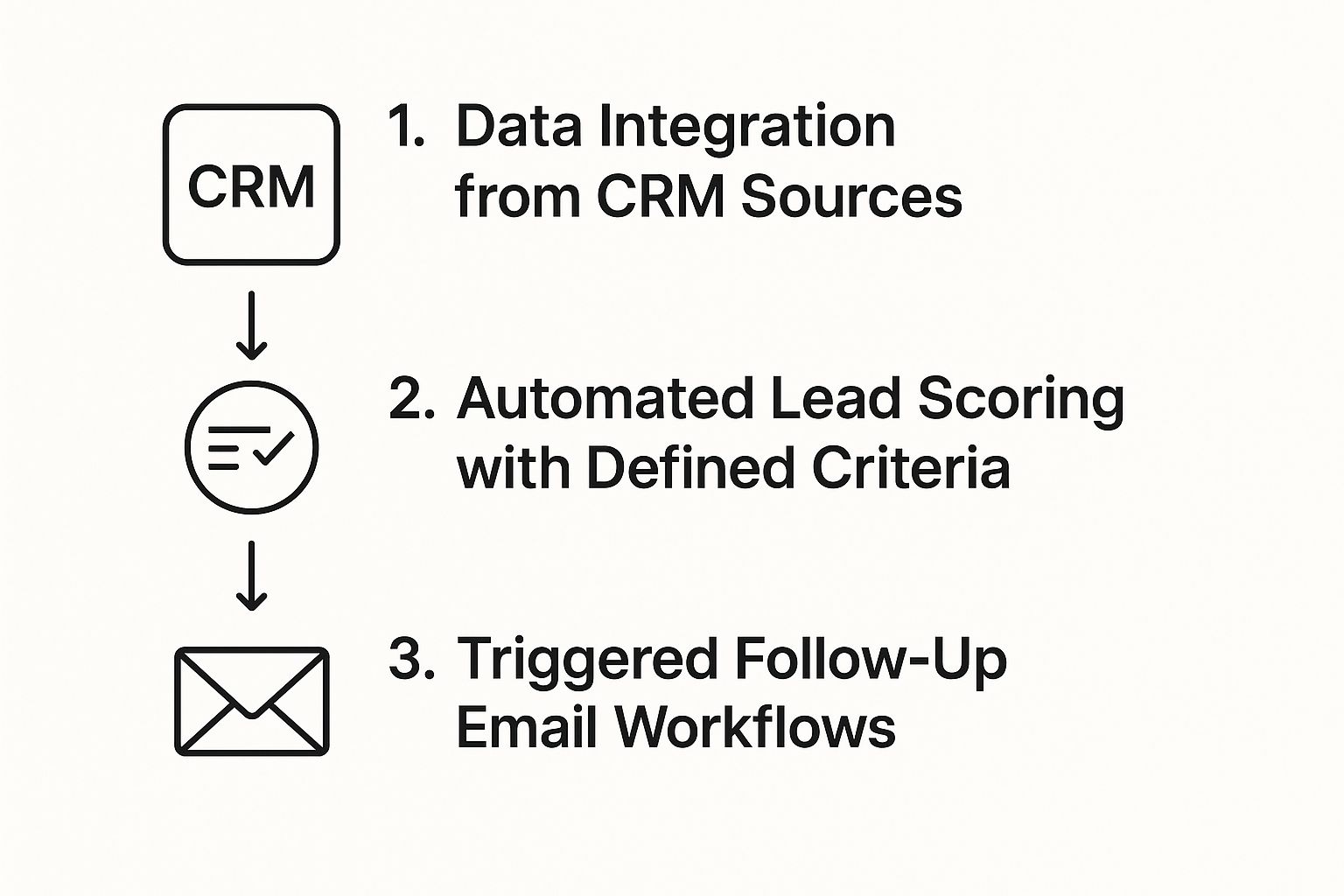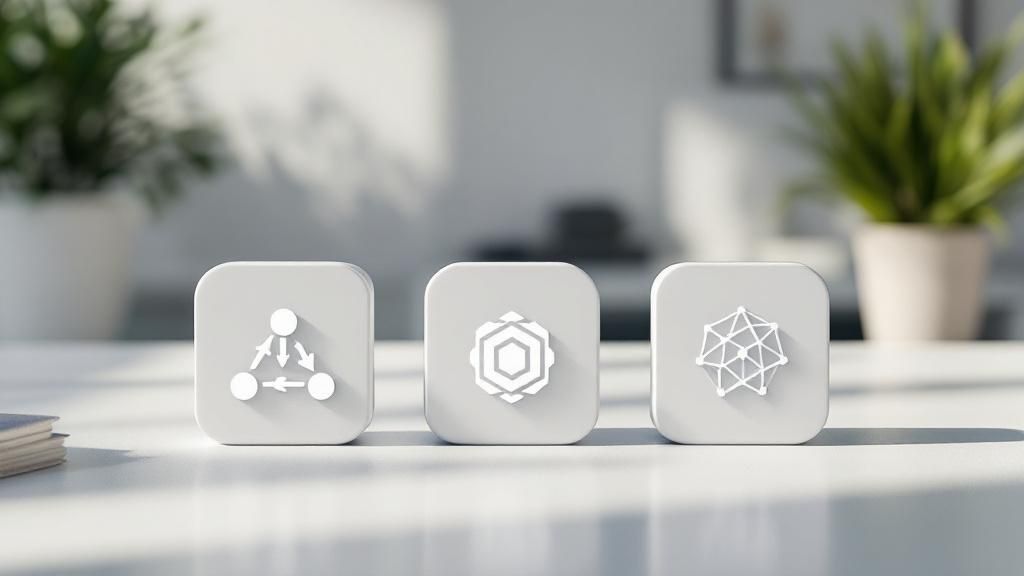Let's be honest, your sales team is probably buried in administrative busywork. Data entry, scheduling follow-ups, manually sorting through leads—it's the kind of tedious work that drains energy and keeps them from what they do best: building relationships and actually selling.
This is where sales process automation comes in.
What Is Sales Process Automation Anyway?
Think of it this way: imagine a master chef prepping for a huge banquet. They could spend all day chopping every single vegetable by hand. Or, they could use modern kitchen tools to handle the repetitive prep work, freeing them up to focus on creating amazing dishes and making sure every plate is perfect.
That's precisely what sales process automation does for your sales reps. It’s not about bringing in robots to replace your top performers. It’s about giving them a hyper-efficient digital assistant that runs on autopilot, handling the predictable, repetitive parts of the sales cycle.
This shift from manual grunt work to smart, automated workflows is quickly becoming the new standard for any team serious about growth. The numbers back this up: the global sales automation software market is already valued at around USD 9.3 billion and is expected to skyrocket to USD 22 billion by 2033. This boom is fueled by powerful and accessible tools built on cloud tech, AI, and machine learning. You can dig deeper into this trend by checking out recent sales automation software market reports.
Manual Grind vs Automated Flow
So, what does this look like day-to-day? Let's get practical. The real magic happens when you see how automation transforms tedious chores into strategic, high-impact selling moments.
This table breaks down the shift from the old way of doing things to a smarter, automated flow.
| Common Manual Task | The Automated Equivalent | How Your Sales Rep Wins |
|---|---|---|
| Manually entering lead data from a web form into the CRM. | Leads from web forms are automatically created and populated in the CRM. | Time Saved & Error Reduction: Reps start their day with clean, accurate data, ready for outreach. |
| Setting calendar reminders to send follow-up emails. | A predefined email sequence is triggered after the first contact. | Consistent Nurturing: No lead falls through the cracks, and communication remains consistent. |
| Guessing which leads are most interested based on intuition. | A lead scoring system automatically prioritizes leads based on their actions. | Focus on Hot Leads: Reps spend their valuable time on prospects who are most likely to convert. |
| Building proposals from scratch for every new opportunity. | Proposals are generated from templates, auto-filling key customer data. | Faster Deal Velocity: The time from qualification to proposal is drastically reduced. |
It's a complete change in how work gets done. You’re not just moving faster; you're building a more reliable and intelligent sales engine that can scale with you.
Core Components of Sales Automation
To really get it, you need to know the three core building blocks that make all this automation possible. Think of them as the gears that turn the entire machine.
- Workflows: This is the heart of the whole operation. A workflow is just a series of automated actions that get set off by a specific event. For instance, when a lead downloads an ebook, a workflow can instantly add them to a nurture sequence and assign them to a sales rep. No manual effort required.
- Triggers: A trigger is the starting pistol for a workflow. It’s the specific event that says "GO!" This could be an action a prospect takes (like visiting your pricing page) or something time-based (like three days passing since your last email).
- Actions: These are the actual tasks your software carries out once a trigger fires. An action could be anything from sending a personalized email, creating a task in your CRM like "Follow up with Jane Doe," updating a contact's status, or pinging a team member on Slack.
By mixing and matching these three elements, you can design a system that runs your sales process with precision. It ensures the right things happen at exactly the right time, every single time, creating a predictable foundation for growing your revenue.
The Real-World Benefits of Automating Your Sales Workflow

Let's move past the theory and talk about what sales process automation actually looks like in the real world. This is where it gets exciting.
Picture a growing business hitting that all-too-familiar productivity wall. Reps are swamped, spending more time updating spreadsheets and logging calls than actually talking to potential customers. It’s a common story, but automation completely rewrites the ending.
Instead of just listing abstract ideas, let's dig into the tangible results. When you automate those repetitive, soul-crushing tasks, you're not just getting work done faster. You're fundamentally changing how your team operates, kicking off a powerful cycle of growth that boosts both output and morale.
Supercharge Team Productivity and Morale
The most immediate win you'll see from automating your sales workflow is the gift of time. By taking over administrative chores like manual data entry, scheduling follow-ups, and updating the CRM, automation hands back precious hours to your sales team every single week.
With this newfound time, they can finally focus on the high-value, relationship-driven activities that only a human can do. Things like navigating complex negotiations, having strategic conversations, and building genuine rapport with clients.
Sales process automation is about augmenting your team, not replacing it. It eliminates the burnout-inducing tasks, empowering your reps to operate at their highest potential and focus on what truly drives revenue.
This shift does wonders for team morale. Reps who feel successful and empowered are naturally more motivated and engaged, which creates a positive feedback loop that lifts performance across the entire team. It's helpful to see how this fits into the bigger picture by looking at the broader key benefits of business process automation across an organization.
Ensure No Lead Is Left Behind
In a manual system, it’s terrifyingly easy for good leads to fall through the cracks. A busy rep forgets a follow-up, a hot inbound lead sits in an inbox for hours, and its potential slowly fizzles out. We've all been there.
Sales process automation puts a stop to this with intelligent lead management. Here’s a quick look at how it works:
- Automated Lead Scoring: The system analyzes a lead's behavior—like website visits, email opens, and content downloads—to assign a score that signals their interest level. This instantly flags the hottest prospects for your team.
- Instant Lead Routing: Once a high-scoring lead pops up, the system can automatically assign it to the right sales rep based on territory, expertise, or even current workload.
- Immediate Engagement: The assigned rep gets notified instantly, allowing them to follow up within minutes, not hours. That speed dramatically increases the odds of making a real connection.
This creates a seamless handoff, ensuring your most valuable opportunities get the prompt attention they need to convert. It's no wonder that 61% of B2B organizations are already on board with sales automation. The proof is in the numbers: teams using this tech report an average productivity bump of 14.5%.
Drive Smarter Decisions with Accurate Data
Let's be honest: manual data entry isn't just slow; it's a breeding ground for expensive mistakes. A single typo in an email address or a misplaced decimal in a deal value can snowball into major problems, from failed outreach campaigns to flawed financial projections.
By automating data capture from your forms, emails, and other touchpoints, you build a single source of truth that is both clean and reliable. The knock-on effects are powerful:
- Accurate Forecasting: With data you can trust, sales leaders can forecast revenue with much greater confidence. This leads to smarter budgeting and better resource allocation.
- Deeper Insights: Clean data lets you run reports that actually mean something. You can spot trends in your sales cycle, identify your best-performing channels, and pinpoint exactly where you need to improve.
- Improved Strategy: You can finally stop making decisions based on guesswork and start building your strategy on a solid foundation of real, accurate metrics.
These benefits all feed into each other. More productivity leads to better lead management, which is powered by accurate data, which leads to smarter strategies and even greater efficiency. If you're wondering where to start, check out our guide on 5 sales processes you can automate to save more time.
Where to Automate in Your Sales Funnel
Applying sales process automation isn't like flipping a single switch; it’s more like strategically placing spotlights on a stage. You need to know exactly where to shine them for the biggest impact. The trick is to map out your sales funnel and pinpoint the high-leverage opportunities at each stage, turning those manual bottlenecks into smooth, automated flows.
Let's follow a lead on its journey, from a curious prospect to a loyal customer, and see exactly where automation can make a world of difference. We'll look at the "before" and "after" to really understand the transformation.
Prospecting and Lead Capture
Before automation, this stage is a time-consuming hunt. Reps spend hours digging around for prospects, sifting through data, and painstakingly punching new contacts into the CRM. It’s slow, it's tedious, and it's a recipe for human error.
Once you bring automation into the mix, this whole process gets a lot smarter.
- Automated Data Enrichment: Tools can automatically pull in valuable data about new leads from public sources like LinkedIn and company websites. A new contact that comes in with just an email address can be instantly fleshed out with a job title, company size, and industry.
- Targeted Prospecting: Instead of casting a wide net and hoping for the best, reps can use automated tools to zero in on prospects who perfectly match your ideal customer profile. This feeds the top of your funnel with much higher-quality leads from the get-go.
This foundational automation ensures your reps start their outreach with rich, accurate context, making that first touchpoint far more relevant and effective. You can get a deeper dive into setting this up by exploring how to automate lead generation.
This flow chart gives a great visual of how data integration, lead scoring, and automated follow-ups all work together to build a seriously efficient system.

As you can see, solid automation starts with clean data from your CRM. That data then fuels intelligent scoring and triggers timely, relevant communication.
Lead Nurturing and Qualification
Without automation, lead nurturing is spotty at best. A busy rep might forget to follow up, or they might just blast out generic, one-size-fits-all emails that don't connect with anyone. Hot leads can go cold simply because they didn't get timely, personalized attention.
With sales process automation, nurturing becomes a dynamic, responsive conversation.
The goal of automation here isn’t to sound like a robot. It’s to ensure that every lead receives consistent, valuable communication that guides them forward, making the eventual human conversation much more productive.
For example, one of the biggest wins is automating sales email follow-up. Instead of reps relying on sticky notes, you can build smart email sequences that adapt based on a prospect's behavior. Did they click a link to a case study? The system can automatically send them a related blog post a few days later. This keeps your brand top-of-mind with content that actually matters to them.
On top of that, AI-powered chatbots can handle initial qualification questions on your website 24/7. This frees reps from answering the same basic questions over and over, letting the bots qualify visitors and even book meetings directly on a rep's calendar.
Closing and Retention
In the final stretch, manual processes can create deal-killing friction. A rep fumbles to create a custom quote, wasting precious time. Endless back-and-forth emails to schedule a final presentation drag out the close.
Automation gets rid of these roadblocks and helps you accelerate your deal velocity.
- Automated Quote Generation: Reps can use templates that pull data directly from the CRM to generate accurate, professional-looking proposals in minutes, not hours.
- One-Click Meeting Scheduling: Forget playing calendar tag. Reps can just send a link to their calendar, allowing the prospect to instantly book a time that works for them.
- Automated Onboarding and Check-ins: Once a deal is won, automation ensures a smooth handoff. A workflow can trigger a welcome email series, assign tasks to the customer success team, and even schedule a 30-day check-in to boost customer satisfaction and build long-term loyalty.
By strategically applying sales process automation at each of these key funnel stages, you don't just speed things up. You create a smarter, more consistent, and more reliable system that empowers your sales team to focus on what they do best: building relationships and closing deals.
How to Implement Sales Automation Without the Headaches

Jumping into sales process automation without a plan is a bit like trying to build a house without a blueprint. You might end up with something standing, but I guarantee it won't be sturdy, functional, or what you actually wanted. A winning strategy gets mapped out long before you even think about picking a tool.
This strategic thinking is what stops you from making the most common mistake: automating a broken process. All that does is help your team do the wrong things, just faster. To avoid the inevitable headaches, you need a clear, intentional framework that puts your process first, not the platform.
This five-step roadmap is your guide to getting it right—from initial analysis all the way to getting your team on board.
Step 1: Start with a Process Audit
Before you can fix anything, you need to understand it inside and out. The first step is a no-holds-barred audit of your current sales workflow. I'm talking about mapping every single step your team takes, from the second a new lead hits the system to the moment a deal is signed.
You have to get granular here. Follow a lead's entire journey and ask the tough questions: Where do my reps get bogged down? Where are leads stalling or just falling through the cracks? Which tasks are mind-numbingly repetitive and begging for human error?
Finding these bottlenecks and time-sinks is how you'll zero in on the areas where automation will give you the biggest bang for your buck.
Step 2: Define Clear, Measurable Goals
Okay, now you know where the fires are. The next step is to define exactly what you want automation to accomplish. Vague goals like "improve efficiency" are completely useless. You need specific, measurable targets that spell out what success looks like for this project.
Good goals sound more like this:
- Slash lead response time from an average of four hours to under 30 minutes.
- Boost the number of qualified leads handed to the sales team by 20% every quarter.
- Cut down time spent on manual data entry by five hours per rep, each week.
These concrete targets do more than just guide your setup; they give you a clear yardstick to measure your ROI later. It transforms the whole thing from a hopeful experiment into a real business initiative.
Step 3: Choose the Right Tools for the Job
With your audit done and goals in hand, now you can start shopping for tools. The market is absolutely flooded with options, but your hard work in the first two steps will act as your filter. Don't let yourself get distracted by flashy features you'll never use. Focus on platforms that solve the specific problems you've already identified.
Keep these key factors in mind:
- Integration: How well does it play with your existing CRM and other must-have software? You want seamless connections, not a clunky workaround.
- Scalability: Can this tool grow with your team and your business? The last thing you want is to outgrow your new system in a year.
- User-Friendliness: Is the interface intuitive? If your team needs weeks of frustrating training just to use it, they won't.
Picking the right tech is a huge decision, and it’s fueling massive growth in the industry. The business process automation market—which counts sales process automation as a major driver—is projected to grow at a compound annual growth rate (CAGR) of 10.7%. We're seeing this trend play out in real-time, with 65% of professionals already using a CRM with built-in automation to manage their pipelines. If you want to dig deeper into this trend, you can explore more findings on business process automation growth.
Step 4: Implement in Manageable Phases
Trying to automate your entire sales process overnight is a guaranteed recipe for chaos. A much smarter approach is to roll out the changes in small, manageable phases. Start with one of the high-impact, low-complexity areas you found in your audit—something like automating the initial follow-up emails to new leads.
A phased rollout lets you build momentum. You can score a quick win, prove the value of the new system to your team, and iron out any kinks on a smaller scale before you tackle the really complex stuff.
This step-by-step method minimizes disruption and makes the whole transition feel less overwhelming for your team. It builds confidence and paves the way for a much smoother, more successful company-wide adoption.
Step 5: Train Your Team for Enthusiastic Adoption
This is it—the final and most critical step. A powerful automation platform is completely worthless if nobody uses it correctly, or even worse, doesn't use it at all. Real adoption is about more than a one-off training session; it demands clear communication and continuous support.
You have to sell the "why" behind the change. Show your reps exactly how this new system is going to eliminate their most tedious tasks, free them up to do what they do best—sell—and ultimately help them crush their quotas and make more money.
Frame it as a tool that empowers them, not one that's trying to replace them. When you turn your team into enthusiastic advocates, you ensure your investment in sales automation actually pays off.
The Essential Sales Automation Tool Stack

Walking through the maze of software all claiming they'll revolutionize your sales can be a headache. But here’s the secret: there's no single magic bullet. The real key is to assemble a "stack" of tools that play nicely together.
Think of it like outfitting a professional kitchen instead of just buying one fancy appliance. Every gadget has its purpose, but they all work in concert to cook up a fantastic meal. The same goes for your sales process automation stack. You start with a solid foundation and then layer on specialized tools for specific jobs, creating a smooth engine where data flows freely, manual work disappears, and your team is freed up to sell.
Let's break down the essential pieces you'll need to build a high-performance system.
The CRM: Your Central Nervous System
Your Customer Relationship Management (CRM) system is the absolute, non-negotiable heart of your entire sales operation. It’s the central hub, the single source of truth where every bit of customer info, every interaction, and every deal stage lives. If your CRM is a mess, any other automation you try to add is just built on quicksand.
Platforms like Salesforce or HubSpot are so much more than digital Rolodexes. They are powerful engines that track every single touchpoint, from a prospect's first visit to your website all the way to the final signed contract. A good CRM gives you the rich data that fuels every other tool in your stack, making intelligent automation even possible.
Email Outreach and Sequencing Platforms
While your CRM knows the who and what, dedicated email outreach platforms handle the how of communicating at scale. These are the tools built to run personalized, multi-step email campaigns that would be a nightmare to manage by hand.
- Intelligent Sequencing: Platforms like Salesloop.io let you build automated follow-up sequences that are actually smart. They react to what a prospect does. If a lead clicks a link or shoots back a reply, the system can automatically pull them from the sequence, so you avoid those awkward, robotic follow-ups that everyone hates.
- Personalization at Scale: These tools pull data from your CRM to pop in dynamic fields—think name, company, or job title—into your email templates. This makes your mass outreach feel much more like a one-on-one conversation.
- Performance Analytics: You get the critical numbers: open rates, click-through rates, and reply rates. This is how you figure out which messages are hitting the mark and which ones need a rewrite.
These platforms are the muscle behind your prospecting and nurturing, making sure you stay in front of people consistently without burning out your reps.
Lead Generation and Prospecting Tools
Your sales funnel needs a constant flow of fresh, quality leads to survive. That’s exactly where prospecting tools shine. These platforms help you pinpoint and gather intel on potential customers who match your ideal profile, feeding your CRM a steady diet of new opportunities.
They completely automate the top-of-funnel research that used to eat up countless hours. By finding the right companies and the key contacts within them, these tools make sure your sales team spends their time talking to the right people.
Effective sales automation isn't just about doing things faster; it's about doing the right things more consistently. Your tool stack should be designed to systematically guide leads through a journey, from initial awareness to a closed deal.
Scheduling and Support Tools
Finally, let's talk about the simple but incredibly powerful tools that kill one of the most annoying parts of sales: the endless "what time works for you?" email chain.
Scheduling platforms like Calendly are a game-changer. Reps can just share a link to their calendar, and prospects can book a slot that works for them with a single click. This tiny piece of automation smooths out the process, speeds up the sales cycle, and just makes you look more professional and modern.
Once you have your stack in place, it’s critical to know how to measure the success of your sales automation strategy to make sure you're actually getting a return on your investment. And if you're curious about how this can help other parts of your business, check out this list of the best business process automation tools to see what else is possible.
What's Next in Sales Automation
The future of sales process automation isn't some sci-fi movie concept—it's happening right now. We're moving past the simple "if this, then that" automations that just handle basic tasks. The next evolution is all about building a sales engine that's not just faster, but genuinely smarter.
It’s about anticipating what a customer needs before they even ask and personalizing every single touchpoint, even when you're dealing with thousands of leads. These aren't just experimental ideas anymore; they're quickly becoming the new standard for any sales team that wants to stay competitive. Let's dig into the key trends that are completely reshaping how we sell.
Predictive Lead Scoring Takes Over
Traditional lead scoring is a good start, but it's always looking backward. It works by giving points to leads for things they've already done, like opening an email or downloading a guide. The next wave, predictive lead scoring, flips that on its head by being proactive. It uses AI to sift through thousands of data points—everything from company size and industry to subtle online behaviors—to pinpoint your best prospects before they've even signaled much interest.
Here’s a way to think about it: traditional scoring is like checking your rearview mirror to see which cars are tailgating you. Predictive scoring is like having a smart GPS that analyzes real-time traffic patterns up ahead, guiding you to the fastest route. It shows you which leads are most likely to buy, so your team can pour their energy into the right conversations and get to those high-value prospects before your competitors even know they exist.
Conversational AI Becomes a True Teammate
Let's be honest, early chatbots were clunky. They could handle a few simple, pre-programmed questions, but they often led to more frustration than help. Today’s conversational AI is a different beast entirely. These are sophisticated digital assistants that can hold their own in complex, human-like conversations.
These modern bots can qualify new leads with smart, nuanced questions, figure out what the person actually wants, and even book meetings right onto a sales rep's calendar.
The real magic of modern conversational AI is its ability to chew through that initial qualification grind, 24/7. No inbound lead ever has to wait. It gathers the essential info, answers the initial questions, and then hands off a warm, fully-briefed lead to a human.
This frees up your team from the repetitive back-and-forth of the early sales stages. They get to step in at the perfect moment—when the prospect is already qualified, informed, and ready for a real strategic discussion. It’s the perfect blend of smart automation and the human touch.
Hyper-Personalization at Massive Scale
Every good salesperson knows that personalization is the key to breaking through. But actually doing it for thousands of leads at once? That's always been the impossible dream. Well, with AI, that dream is finally here. Hyper-personalization uses AI to comb through data from your CRM, social media, and other sources to create truly unique and relevant outreach for every single person.
And we're talking about much more than just dropping in a [First Name] tag. Modern AI can:
- Reference a prospect’s latest blog post in an outreach email.
- Bring up a specific company milestone, like a recent round of funding.
- Tweak the message's tone based on the prospect’s industry and job title.
Imagine this level of personal detail, delivered automatically to thousands of contacts. It makes every prospect feel like they’re getting a message written just for them. In today's crowded market, it's that deep, authentic relevance that actually gets a response.
Common Questions About Sales Automation
Even with all its obvious upsides, I get that diving into sales process automation can bring up some valid questions. It's a big step. So, let’s tackle the most common ones head-on, cut through the noise, and get you the clear, practical answers you need to move forward with confidence.
Will Automation Replace My Sales Team?
This is easily the biggest myth out there, and the answer is a hard no. The goal of sales automation isn't to replace your people; it's to unleash them.
Think of it like this: you wouldn't ask your star quarterback to also handle laundry and book the team's travel. You'd have a support crew for that. Automation is that world-class support crew for your sales team.
It takes over the repetitive, soul-crushing tasks that burn out even the best reps—things like manual data entry, sending basic follow-ups, and scheduling. This frees your team up to focus on the high-value, uniquely human stuff: building genuine relationships, navigating complex negotiations, and strategically closing deals.
How Much Does This Type of Automation Cost?
The price tag for sales automation tools can be all over the map. You'll find everything from affordable per-user plans baked into modern CRMs to more significant investments for massive enterprise platforms. But honestly, focusing only on the sticker price is a classic mistake.
The only metric that truly matters is your return on investment (ROI).
A smart automation strategy should pay for itself, and quickly. When you start adding up the value of reclaimed sales hours, higher lead conversion rates, and the complete elimination of costly human errors, the right system stops being an expense. It becomes a profit-generating engine.
The most expensive option is almost always sticking with what you're doing now. The hidden costs of missed opportunities, slow follow-ups, and rep burnout will dwarf the software subscription fee every time.
What Is the Biggest Mistake to Avoid?
I see this one all the time. The single biggest mistake you can make is trying to automate a broken process.
If your current sales workflow is messy, confusing, or just plain doesn't work, throwing technology at it will only make you fail faster. You'll just be doing the wrong things at a much greater scale. It's a recipe for disaster.
Before you even think about looking at software, you have to map, analyze, and fix your manual process. Find the bottlenecks. Clarify the steps. Make sure it all makes sense from start to finish.
Only when you have a clean, efficient, and proven workflow should you start automating it. That’s how technology becomes a powerful accelerator for a winning strategy, not just a digital Band-Aid on a fundamental problem.
Ready to stop wasting time on manual tasks and empower your team to sell more effectively? Salesloop.io provides the powerful, intuitive multichannel sales outreach platform you need to automate your campaigns and accelerate pipeline growth. Start building your automated sales engine today.





